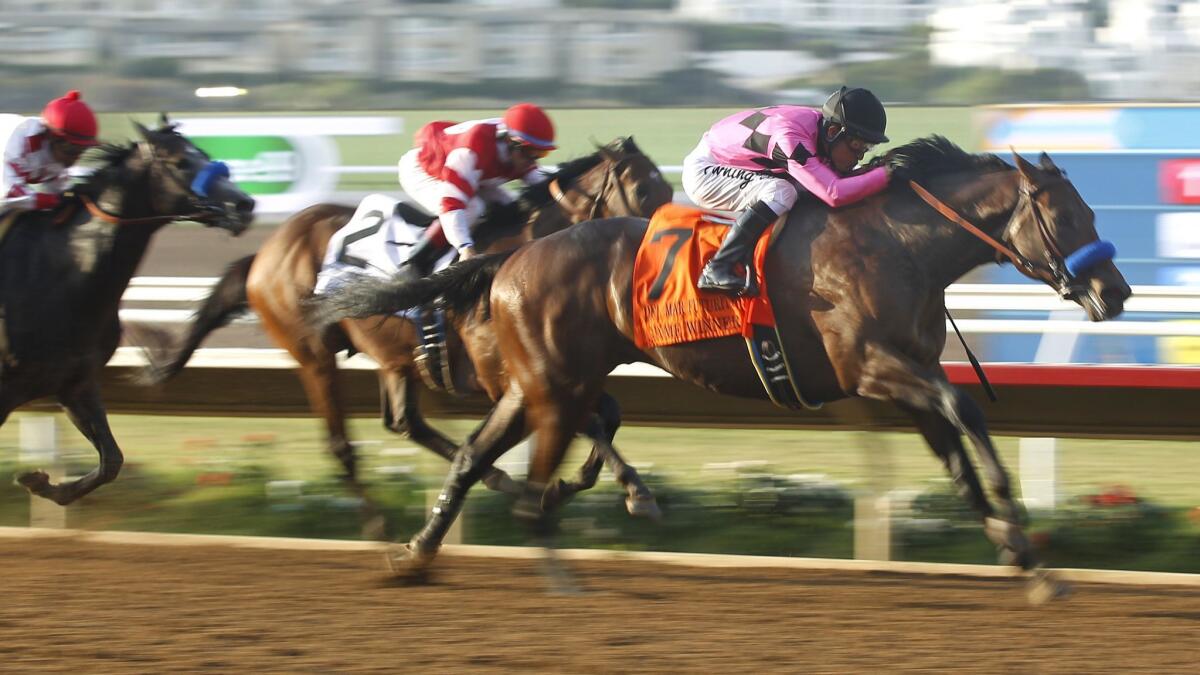The Juvenile is Friday’s marquee race at the Breeders’ Cup, but many top 2-year-olds will be missing
- Share via
Reporting from LOUISVILLE, Ky. — This year the Breeders’ Cup decided to change its format and run all the 2-year-old races on Friday, making the Juvenile the marquee event on the first day of the two-day, $30-million collection of races.
The question now becomes are the horses we’re seeing worthy of the extra attention?
Instagrand, who won his only two races by a combined 20 lengths, has been shelved for the rest of the year to get ready for his 3-year-old campaign. Roadster, after running two races, was given the rest of the year off to mature and should be back in February. In fact, the top six horses in the Breeders’ Cup Juvenile futures pool, which closed on Sept. 2, are skipping the race, mostly because they just needed more time to be ready for next year. Instagrand was the pool favorite at 7-2 and Roadster was second at 6-1.
This year the average number of races that the 14 horses have run is 3.14. Just three years ago, when Nyquist won it, the average was almost one race higher at 3.92. If you go back to the very first Breeders’ Cup in 1984, the average was 5.2. The winner of the first Juvenile, Chief’s Crown, ran eight races before the Breeders’ Cup. Everyone likes to point to Seabiscuit’s 35 starts as a 2-year-old in 1935. He was clearly still developing with an unimpressive five wins.
The reasons for the current lack of races for 2-year-olds, at a time when racing needs to showcase its present and future stars, are varied.
Hall of Fame jockey Mike Smith thinks part of it has to do with size.
“A lot of these horses coming along are so big, and you have to give them a little time,” Smith said. “To get ready by running fewer races, the horse has to have the mind that [this year’s Triple Crown winner] Justify had. A lot of them have the ability. A lot of them are extremely talented. But to have the mind to go with it without the seasoning of a 2-year-old is very difficult.”
When horses are bought at auction the old rule was you looked for “conformation, quality, substance and soundness.” Substance loosely means things such as bone density. Now, the ability to measure every aspect of a horse’s health has made trainers more cautious.
“Since we’ve gotten the capabilities, we’ve done more than 12,000 nuclear scintigraphy scans at Santa Anita,” said Dr. Rick Arthur, equine director at both the UC Davis School of Veterinary Medicine and the California Horse Racing Board. “We may have more information than you really want to have. It’s improved the care of the individual horse, but it’s made decisions much more complicated.”
Doug O’Neill, who trained Nyquist, sees the issue from a West Coast perspective.
“I think there is a little bit of a situation out West where the 2-year-old stakes program has dwindled,” O’Neill said. “There is not a lot of incentive to get horses to run early. If you get them ready, there is nowhere to run for months. If they brought back a really nice 2-year-old stakes program, you would see them race more.”
The perception of building a foundation through racing was thrown askew this year when Justify became the first horse that had been unraced as a 2-year-old to win the Kentucky Derby since Apollo in 1882.
Bob Baffert, Justify’s trainer, doesn’t see a correlation and thinks little has changed in how to get a horse ready for the Kentucky Derby.
“The reason it happened was Justify had an issue earlier in the year and that’s why he couldn’t make it,” Baffert said. “We weren’t even thinking Derby with him. He just happened to break his maiden impressively and then he came back and won that allowance race and that’s when I started thinking Derby.
“I was thinking if he’s a super horse, he can get it done, and you know, he turned out to be a super horse. You can only do it with those kind of horses.”

O’Neill agrees with Baffert as to there being no magic formula.
“I don’t think there is a right number of races,” O’Neill said. “Bob proved it with Justify. There is no doubt in my mind.”
But not racing much as a 2-year-old may have its downside.
“Horses have to adapt their bones to the stress of racing,” Arthur said. “They are more adaptable at 2 than at any other time. … When they get older, the bone is not as responsive. Racehorse bones need a tremendous amount of modeling to handle the rigors of racing.”
There will be some modeling going on when the 14 horses with a total of 44 races among them compete Friday in the 1 1/16-mile Juvenile. Game Winner, running for Baffert, will bring a three-race undefeated streak into the Juvenile as the 8-5 favorite.
The race will follow the Juvenile Turf Sprint, Juvenile Fillies Turf, Juvenile Fillies with three-time winner Bellafina, and the Juvenile Turf.
Click here (or type in this url: lat.ms/2wVt90g) to sign up for our free horse racing newsletter.
More to Read
Go beyond the scoreboard
Get the latest on L.A.'s teams in the daily Sports Report newsletter.
You may occasionally receive promotional content from the Los Angeles Times.











